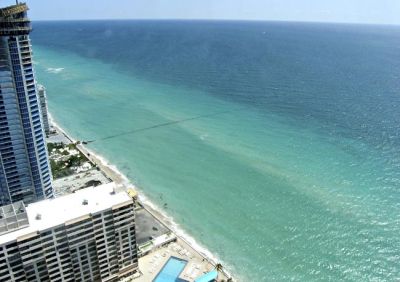
When you step on this beach in Broward County, everything looks the same, clear blue green water, sand, sand and more sand, a picturesque view, until someone tells you that you are standing on glass. What? Amazed by what I just said but that is the truth actually. The sand underneath your feet might look like sand, it may feel like sand too but if you look carefully you can make out that the granules sparkle and reflect the sunlight.
The effort has been done to save the beaches (especially Florida ones) from the constant erosion they undergo which creates gaps and leaves shallow spaces along the coastal line. To fill these up, the Broward County officials are using recycled glass which is then crushed into micro granules and mixed with regular sand to be laid down on these beaches. Since, glass is basically made up of sand, the idea is considered safe and ecological too. The county is also the first among nations to use glass in such a manner.
Phil Bresee, Broward’s recycling manager said,
Basically, what we’re doing is taking the material and returning it back to its natural state.
Paden Woodruff of the state Department of Environmental Protection quoted, ‘You reduce waste stream that goes to our landfills and you generate materials that could be available for our beaches.’ The idea got all the hype when researchers noticed that unintentional dumping of glass wastes near Fort Bragg in Northern California gradually degraded and became as smooth as the sand itself. That area is now known as the ‘glass beach’.
We have been witnessing the value of land till now but in Florida; sand is a precious commodity too which has its own business. In south Florida especially the business generates a whopping $1 billion a year. The irony is like land, the sand is also becoming scarce. Since 1970, as per the Broward officials some 13 million tons of sand has been piped out from the ocean floor to fill up the beaches. However, now with the ecologists being concerned about reef life and protection that is interrupted when sand is dredged, glass has been left as the only option. Right now, the county produces some 15, 600 tons of glass every year that proves to be enough to deal with the situation right now. As per statistics, some $80 million are spent every year in an effort to restore Florida’s beaches justifying the fact that more than a quarter of coastline of Florida that is about 1,350-mile witness critical and wide scale erosions each year. The same practice has been going on to save Lake Hood in New Zealand and the Dutch Caribbean island of Curacao.
However, there is another side of the story too. As a senior scientist with the Ocean Conservancy, Mr. Dennis Heinemann puts it,
There’s no way that you can predict all the environmental consequences of an action like this. There always will be unforeseen consequences.
Glass replacing sand, what’s next?
Source: Livescience


